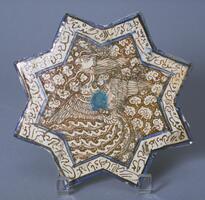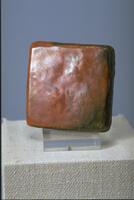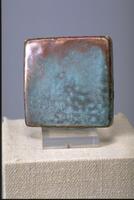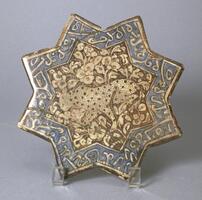41 UMMA Objects
41 UMMA Objects

Iranian (Iranian)
Star-shaped tile with molded floral design
1400 – 1599
Transfer from the College of Architecture and Design
1972/2.135
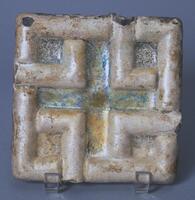
Syrian
Square tile with molded cross design
1100 – 1299
Transfer from the College of Architecture and Design
1972/2.145

Iranian (Iranian)
Tile fragment with inscription
1100 – 1299
Transfer from the College of Architecture and Design
1972/2.152
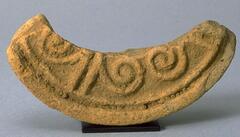
Chinese (Chinese (culture or style))
Roof Tile
2nd century
Gift of Dr. and Mrs. Peter Greiner
1979/2.7
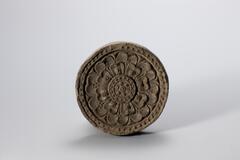
Korean (Korean (culture or style))
Roof-end tile with lotus design
676 – 935
On loan from the YooGeum Museum, Seoul, Korea
LTL2009.7.7
![This curved tile has small circles lining the edge of the two long, curved edges, and two shorter straight edges without special border decoration. The face of the tile is decorated with vegetal arabesque motif.<br />
<br />
This gray-white, low-fired earthenware concave eave-end roof tile features a scroll design. Although each motif on the front decorative surface of the tile is different, the scroll design demonstrates some degree of left-right symmetry. Traces of a parallel pattern made by a paddle four centimeters wide are visible on the flat surface of the tile. Traces of trimming and smoothing with water are also visible on the sides and joints.
<p>[Korean Collection, University of Michigan Museum of Art (2017) p. 40]</p>
This curved tile has small circles lining the edge of the two long, curved edges, and two shorter straight edges without special border decoration. The face of the tile is decorated with vegetal arabesque motif.<br />
<br />
This gray-white, low-fired earthenware concave eave-end roof tile features a scroll design. Although each motif on the front decorative surface of the tile is different, the scroll design demonstrates some degree of left-right symmetry. Traces of a parallel pattern made by a paddle four centimeters wide are visible on the flat surface of the tile. Traces of trimming and smoothing with water are also visible on the sides and joints.
<p>[Korean Collection, University of Michigan Museum of Art (2017) p. 40]</p>](/media/W1siZiIsIjIwMjEvMDIvMTkvOHh3OXdiaXozOV9kZWZhdWx0LmpwZyJdLFsicCIsInRodW1iIiwiMjQweDIwMCJdXQ?sha=c308a2996283af45)
Korean (Korean (culture or style))
Untitled
676 – 935
On loan from the YooGeum Museum, Seoul, Korea
LTL2009.7.11
![Earthenware roof tile-end with molded lotus design.<br />
<br />
This gray, high-fired earthenware convex eave-end roof tile features a slender thirteenpetal lotus design. It is made from coarse clay mixed with small stone particles. The circular ovary and lotus seeds are depicted in shallow relief, while the lotus petals are slender and lack volume.<br />
[Korean Collection, University of Michigan Museum of Art (2017) p.36] Earthenware roof tile-end with molded lotus design.<br />
<br />
This gray, high-fired earthenware convex eave-end roof tile features a slender thirteenpetal lotus design. It is made from coarse clay mixed with small stone particles. The circular ovary and lotus seeds are depicted in shallow relief, while the lotus petals are slender and lack volume.<br />
[Korean Collection, University of Michigan Museum of Art (2017) p.36]](/media/W1siZiIsIjIwMjIvMDkvMjQvOXVkYnJyYnlyaV9kZWZhdWx0LmpwZyJdLFsicCIsInRodW1iIiwiMjQweDIwMCJdXQ?sha=8f6c2bf6c7b8db77)
Korean (Korean (culture or style))
Roof Tile-End with Lotus Design
676 – 935
Gift of Bruce and Inta Hasenkamp and Museum purchase made possible by Elder and Mrs. Sang-Yong Nam
2004/1.196
Loading…
